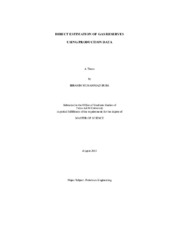| dc.description.abstract | This thesis presents the development of a semi-analytical technique that can be used to estimate the gas-in-place for volumetric gas reservoirs. This new methodology utilizes plotting functions, plots, extrapolations, etc. - where all analyses are based on the following governing identity. The 'governing identity' is derived and validated by others for pi less than 6000 psia. We have reproduced the derivation of this result and we provide validation using numberical simulation for cases where pi greater than 6000 psia. The relevance of this work is straightforward using a simple governing relation, we provide a series of plotting functions which can be used to extrapolate or interpret an estimate of gas-in-place using only production data (qg and Gp). The proposed methodology does not require a prior knowledge of formation and or fluid compressibility data, nor does it require average reservoir pressure. In fact, no formation or fluid properties are directly required for this analysis and interpretation approach. The new methodology is validated demonstrated using results from numerical simulation (i.e., cases where we know the exact answer), as well as for a number of field cases.
Perhaps the most valuable component of this work is our development of a "spreadsheet" approach in which we perform multiple analyses interpretations simultaneously using MS Excel. This allows us to visualize all data plots simultaneously - and to "link" the analyses to a common set of parameters. While this "simultaneous" analysis approach may seem rudimentary (or even obvious), it provides the critical (and necessary) "visualization" that makes the technique functional. The base relation (given above) renders different behavior for different plotting functions, and we must have a "linkage" that forces all analyses to "connect" to one another. The proposed multiplot spreadsheet approach provides just such a connection. | en |


